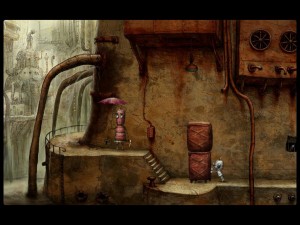Machinarium
 In my weekend Super Meat Boy session, I unlocked a new playable character: Josef, the protagonist of Machinarium, a game that, coincidentally, was recently ported to the iPad. Taking this as a cue to finally play the thing, which has been languishing on the Stack ever since its inclusion in a Humble Indie Bundle, I have now gotten a taste of both the PC and iPad versions.
In my weekend Super Meat Boy session, I unlocked a new playable character: Josef, the protagonist of Machinarium, a game that, coincidentally, was recently ported to the iPad. Taking this as a cue to finally play the thing, which has been languishing on the Stack ever since its inclusion in a Humble Indie Bundle, I have now gotten a taste of both the PC and iPad versions.
Machinarium was created by the same team as Samorost and its sequel, and has something of the same feel. It’s a more coherent world, both logically and artistically, and more like a conventional point-and-click adventure, with an inventory, and an avatar whose actions you control and who goes where you click (although only approximately: it’s more like he has a set of fixed positions that he can move between, but the UI presents it as if it were classic Sierra/Lucasarts-style navigation). But it has something of the sensibilities of a twitch-and-wiggle game, where you seldom know at first what a given click will bring. Even the splash screen emphasized this: the very first thing you see in the game is the title drawn in thick letters with a scribbly fill (anticipating the illustrative style used throughout), which warp and morph when the cursor passes over them.
Our cleverer readers may now be wondering how they manage that on the iPad, which doesn’t have a cursor in the same sense as the PC. The answer is that they don’t. The iPad version skips the splash screen entirely. This is just one of several small ways in which the PC version is superior. The lack of a persistent cursor on the touchscreen means that there’s less feedback about what’s clickable; the game shows a cursor briefly when you tap things, but you lose the passive feedback. There are a few places where the iOS version compensates for this by superimposing arrows on the screen to indicate actions you might otherwise miss (which is particularly important in timed sequences), but this is an inelegant solution. I suppose that for some people the convenience of portability, or even just love of Apple, will counterbalance these deficiencies, but I intend to finish the game with a mouse, even though I’m farther along on the iPad at this point.
Now, I said that the protagonist is named Josef, but I have to take Ed McMillen’s word for this, because, like Samorost, the game itself is completely wordless (apart from a few early tooltips that instruct the player in basic controls). Even the hints are wordless, showing rather than telling the actions you must take, in comics form. Talking with other characters yields voice-like squeals and gibberish, often accompanied by a cartoon-style speech balloon bearing a picture of what that character wants from you. In typical adventure-game fashion, this usually means a sub-goal you need to achieve to get what you want from them, but there’s at least one case where it’s a complete red herring. I think the use of pictures instead of words made this particularly unexpected: how could I doubt the existence of an item I had seen?
Josef is a robot, as are all the inhabitants of the city where the game takes place, including the animals. (Possibly the city itself is called Machinarium? As with Josef’s name, this is unclear from the game content.) It’s a ramshackle place and the robots all seem old and dented and in need of a good cleaning and oiling, badly repaired or perhaps just awkwardly designed. But it’s a graceful sort of awkwardness. Josef himself frequently displays a machine’s imperviousness to discomfort, for example allowing himself to go stiff, tip over, and fall from a ladder instead of going to the effort of climbing down. In effect, he temporarily becomes an inanimate object during this animation. A city of robots is a place where the distinction between the animate and the inanimate is not rigid, and that cuts both ways: any machine can become a character, with its own motivations and opinions. It’s a bit like what Syberia was trying to do, but to a greater extreme and with more of a sense of humor.
 Comments(4)
Comments(4)
Wait–a pictoral red herring? I don’t remember that. Which bit are you thinking of?
I refer to this.
Hm, that didn’t faze me too much. The bartender is giving the price of the oil, but I always figured that tricking him would be an option.
Not to say that that puzzle didn’t drive me to a walkthrough. (An offline walkthrough, because the spider-and-key game just killed me, and anyway I wanted a couple of steps instead of the whole thing.) But I wasn’t too surprised that the solution didn’t involve actually finding the money.
Wow, I think I managed to miss that entirely.